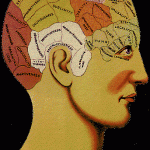Phrenology
There is no doubt that most of us have an interest in Whitman and how he thinks, otherwise I don’t think many of us would be in this class! Clearly, his ideas and beliefs were so far ahead of their time; so perhaps his brain worked in ways that some of us can not even fathom. In fact, I’m sure many of us have said “Man, I’d like to pick Walt Whitman’s brain!” Well, the funny thing is, that scientists actually have.
Here’s just a quick history in Phrenology for you: Whitman had a love of the mind, both figuratively and literally. In his time, Phrenology was the study of the mind. Obviously, nineteenth century America did not have the technological luxuries we have today so the practice is labeled as a “pseudo-science” today. This science was based on the shape of one’s skull and determining different types of personality traits from it. It was believed then that the brain was made up of 27 different “organs” and each had a distinct personality trait. A phrenologist would run his hands over the skull and look for enlargements or irregularities of any kind. After having done this, he could then assess the person’s character or treat any disorders that might be found. This science was used not only to explain certain mental disorders we know of today, but also used to determine a child’s future and possible marriage options for them.


Neurological Advances have obviously made this practice obsolete, but it was considered incredibly avant-garde in Whitman’s time.
In 1849, Whitman had his own phrenological reading done and this is probably why he had such a strong calling to it. Orson and Lorenzo Fowler were brothers who made this science of Phrenology into a business during this time. They were the one’s who gave Whitman insight into this practice and ultimately gave him his first reading. The Fowler brothers would also go on to sell the first edition of Leaves of Grass, which Whitman published himself. (Mackey)
Whitman was so influenced by Phrenology that it can be seen throughout many of his works. He uses phrenological terms such as Amativeness and Adhesiveness. Amativeness is a term that describes sexual desire and reproductive instinct. From a phrenological standpoint, it is located on the lower side on the back of the head, between the ears. This is something that is very obviously seen throughout much of Whitman’s work. There is no doubt that many of his poems are sexually charged and some very sexually explicit. He seemed to be very open with his idea’s about how men and women are meant to be sexual beings. He felt as though the body was something to celebrate and worship, not something to be ashamed of.
Adhesiveness, or affection, is the term used for friendship. This was said to be found on the posterior part of the parietal bone; or for those of us with little knowledge of the skull, it’s on the back portion of the head. The idea of friendship or adhesiveness is also seen a lot in Whitman’s work. What strikes me about this is friendship and sexuality seem to go hand in hand with Whitman. He tries to dismiss any feelings homosexuality with the idea that the men he speaks of are “just friends.” It seems that these two ideas, amativeness and adhesiveness coincide greatly with him perhaps because of his sexuality.
Not only does Whitman’s work illustrate his love of this science, but his posthumous years do as well. Whitman donated his body to science and his brain was obtained by the American Anthropometric Society. In 1911, Dr. Edward Spitzka took part in an experiment in which he disected the brains of one hundred of the greatest minds of the time. Edgar Allen Poe was in the group, as well as our Walt Whitman. He studied these “educated and orderly” brains along with the brains of the “illiterate and disorderly.” In the article, Spitzka mentions that “an accident befell” Whitman’s brain. He goes on to mention that the brain was kept very well preserved. however, “some careless attendent in the laboratory let the jar fall to the ground” It was never stated if the brain was destroyed but “it’s a pity not even the fragments were recovered.” (NYtimes, 1911)
Here’s a little idea of what that might have been like: True Story
I found Whitman’s devotion to science very fascinating and adds to his nature of being ground-breaking. He seemed to be interested in all things progressive. Perhaps this relates back to his personal self and wanting to know why one thinks the way they do and how some think differently than others. Any way you look at it, Whitman does not seem to have any barriers in his life and is open to anything, which is perhaps why he was the great poet that he was.
Bibliography:
Phrenology in America; Matthew C Vulkin. Department of Psychology, Hanover College
http://clearinghouse.missouriwestern.edu…
Phrenological Whitman, Nathan Mackey
http://www.conjunctions.com/archives/c29…
The History of Phrenology on the Web, John Van Wyhe
http://www.historyofphrenology.org.uk/sy…
http://www.phrenology.org/faculty.html
NyTimes; Septemer 29, 1912.
http://query.nytimes.com/gst/abstract.ht…
Sorry this is late everyone! The flu can sure wipe you out! ![]()